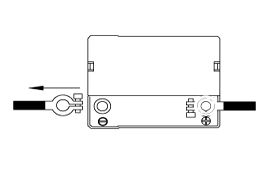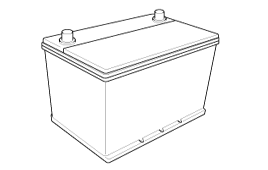Remove the battery from the vehicle.
Care should be taken in the event the battery case is cracked or leaking, to protect your skin from the electrolyte. Heavy rubber gloves (not the household type) should be worn when removing the battery.


Inspection Items & contents | Judgment criteria | Responsibility | Remarks | |
User | Manufacturer | |||
1. Acid Leakage * Type of acid leakage - Leakage on the fusion part for joining the case and cover. - Leakage on the terminal part - Leakage on the other parts * Clean the wet part or wash it, then dry it before checking with naked eyes. * Determine a part where leakage might have occurred ; check it by tipping the battery, if the leakage takes place again. * Conduct a visual inspection for breakage, deformation, or cracks. | 1. Damage in the case or cover due to outside impact. | ○ | ||
2. Acid leakage on the molding part of the case or cover. (weld line or gate hole) | ○ | |||
3. Damage on the terminal or cracks in the cover. | ○ | |||
4. Acid leakage due to the tipped battery or slant storage. | ○ | |||
5. Acid leakage due to poor welding of the cover. (with no damage) | ○ | |||
2. Outside damage and breakage * Check with naked eyes. | 1. Outside damage due to causes without damage due to mistreatment. | ○ | ||
2. Outside damage due to mistreatment. | ○ | |||
3. Damage due to a spark between terminals. | ○ | |||
4. Damage and breakage due to heat. | ○ | |||
3. Measure the voltage for the battery ; but wait at least one day before measuring in case of recharging, and recharging should be made in accordance with the charging instructions. | 1. 12.0V | ○ | Refer to load test | |
2. 11.0V< battery voltage<12.0V due to over-discharge. | ○ | Refer to load test | ||
3. Below 11.0V due to charge condition failure. | ○ | Refer to load test | ||
4. Below 11.0V due to discharged for a long period. | ○ | Refer to load test | ||
5. Below 11.0V due to internal short circuit. | ○ | Refer to load test | ||
4. Load test ; For 15 seconds with a half of the CCA electric current value, but the voltage on the dischaarging stage should be above 9.6V (27±5°C) - Conduct the test with a battery tester. (Refer to the tester manual) | 1. Load test result: below 9.5V | ○ | ||
2. Load test result: above 9.6V | ○ | Mfg. Defect usable | ||
Perform the following steps to complete the load test procedure for maintenance free batteries.
Connect the load tester clamps to the terminals and proceed with the test as follow :
If the battery has been on charge, remove the surface charge by connect a 300 ampere load for 15 seconds.
Connect the voltmeter and apply the specified load.
Read the voltage after the load has been applied for 15 seconds.
Disconnect the load.
Compare the voltage reading with the minimum and replace the battery if battery test voltage is below that shown in the voltage table.
Voltage | Temperature |
9.6 | 20°C (70°F) and above |
9.5 | 16 °C (60 °F) |
9.4 | 10 °C (50 °F) |
9.3 | 4 °C (40 °F) |
9.1 | -1 °C (30 °F) |
8.9 | -7 °C (20 °F) |
8.7 | -12 °C (10 °F) |
8.5 | -18 °C (0 °F) |
If the voltage is less than shown in the table, the battery is good.
If the voltage is greater than shown in the table, replace the battery.
Make sure the ignition switch and all accessories are in the OFF position.
Disconnect the battery cables (negative first).
Remove the battery from the vehicle.
Care should be taken in the event the battery case is cracked or leaking, to protect your skin from the electrolyte. Heavy rubber gloves (not the household type) should be worn when removing the battery.

Inspect the battery carrier for damage caused by the loss of electrolyte. If acid damage is present, it will be necessary to clean the area with a solution of clean warm water and baking soda. Scrub the area with a stiff brush and wipe off with a cloth moistened with baking soda and water.
Clean the top of the battery with the same solution as described in Step(3).
Inspect the battery case and cover for cracks. If cracks are present, the battery must be replaced.
Clean the battery posts with a suitable battery post tool.
Clean the inside surface of the terminal clamps with a suitable battery cleaning tool. Replace damaged or frayed cables and broken terminal clamps.
Install the battery in the vehicle.
Connect the cable terminals to the battery post, making sure the tops of the terminals are flush with the tops of the posts.
Tighten the terminal nuts securely.
Coat all connections with light mineral grease after tightening.
When batteries are being charged, an explosive gas forms beneath the cover of each cell. Do not smoke near batteries being charged or which have recently been charged. Do not break live circuits at the terminals of batteries being charged. A spark will occur when the circuit is broken. Keep open flames away from the battery.
